Coal Wall Spalling Mechanism and Grouting Reinforcement Technology of Large Mining Height Working Face
Abstract
:1. Introduction
2. Engineering Background and Failure Characteristics of the Working Face
2.1. Engineering Overview
2.2. Overview of Coal Wall Spalling at the Working Face
3. New Polyurethane Composite Materials and Complete Technology for Coal and Rock Reinforcement
3.1. Development of New Grouting Materials
3.2. Grouting Equipment and Grouting Technology
4. Numerical Simulation Verification of Grouting Effect
4.1. Model Design Size
4.2. Comparative Analysis before and after Grouting
4.2.1. Comparison of Advanced Abutment Pressure before and after Grouting
- The stress reduction area is 0–3 m in front of the working face, which is the most significant area of coal fragmentation in front of the working face. The cracks in the coal body are crisscross and there is a risk that the whole coal body will fall off.
- Severely affected area, 3–10 m ahead of the working face. The area is the face of the advanced abutment pressure severely affected area. In this area, the stress value increases sharply to the peak stress, and then falls sharply. The stress on the coal within the scope of the region is the strongest with high stress causing the coal to be broken.
- The slowly decreasing area is 10–30 m in front of the working face. This area is the front part of the working face advanced abutment pressure influence area. The deformation increases slowly and the stress value decreases slowly, which has a continuous effect on the coal body in the area and the coal fracture is small in area.
- In the original rock stress area, beyond 30 m in front of the work, the stress value of coal in this area gradually decreases to the original rock stress and the integrity of coal in this area is good.
4.2.2. Plastic Zone Analysis of Working Face before and after Grouting
5. Grouting Scheme and Field Engineering Practice
5.1. Coal Wall Spalling Mechanism Analysis of Working Face
5.2. Grouting Scheme
5.3. Field Effect Analysis
6. Conclusions
- The working face has a large mining height, there are many faults and folds in the mining area and the roof of the coal seam is weak.
- A new nano-composite low temperature reinforcement material was developed, which has the characteristics of rapid reaction, low polymerization temperature, adjustable setting time, high strength and environmental protection.
- Through field observation and numerical simulation, the strength difference of the coal wall in the 150505 fully mechanized working face of Duanwang Mine, before and after grouting, was analyzed. It was found that the stability of the coal wall in the working face was significantly enhanced and rib spalling was significantly improved after comprehensive rib spalling prevention grouting measures were adopted.
- Based on investigation of the 150505 fully mechanized working face in the Duanwang Mine, a comprehensive prevention and control scheme of rib grouting reinforcement was proposed and industrial tests were carried out. The grouting reinforcement effect obtained was clear.
Author Contributions
Funding
Institutional Review Board Statement
Informed Consent Statement
Data Availability Statement
Acknowledgments
Conflicts of Interest
References
- Yu, X.Y.; Wang, Z.S.; Yang, Y.; Mao, X. Discrete element numerical simulation of overburden movement law in fully mechanized top-coal caving mining with large mining depth. J. Min. Strat. Control Eng. 2021, 3, 01353. [Google Scholar]
- Wang, H.B. Study on Mining Pressure Behavior and Coal Wall Reinforcement Technology of Soft Coal Island Face with Large Dip Angle. Ph.D. Thesis, China University of Mining and Technology (Beijing), Beijing, China, 2014. [Google Scholar]
- Liu, Q. Study on Coal Wall Spalling Control Based on Working Condition of Fully Mechanized Mining Support with Large Mining Height. Ph.D. Thesis, Taiyuan University of Technology, Taiyuan, China, 2019. [Google Scholar]
- Zhang, J.X.; Ju, Y.; Zhang, Q.; Ju, F.; Xiao, X.; Zhang, W.; Zhou, N.; Li, M. System and method of low damage mining of mine ecological environment. J. Min. Strat. Control Eng. 2019, 1, 013515. [Google Scholar]
- Zhao, Y.L.; Zhang, L.Y.; Liao, J.; Wang, W.J.; Liu, Q.; Tang, L. Experimental study of fracture toughness and subcritical crack growth of three rocks under different environments. Int. J. Geomech. 2020, 20, 04020128. [Google Scholar] [CrossRef]
- Liu, J.H.; Zhao, Y.L.; Tan, T.; Zhang, L.Y.; Zhu, S.T.; Xu, F.Y. Evolution and modeling of mine water inflow and hazard characteristics in southern coalfields of China: A case of Meitanba mine. Int. J. Min. Sci. Technol. 2022, 32, 513–524. [Google Scholar] [CrossRef]
- Zhao, Y.L.; Liu, Q.; Zhang, C.S.; Liao, J.; Lin, H.; Wang, Y.X. Coupled seepage-damage effect in fractured rock masses: Model development and a case study. Int. J. Rock Mech. Min. Sci. 2021, 144, 104822. [Google Scholar] [CrossRef]
- Zhu, S.T.; Feng, Y.; Jiang, F.X.; Liu, J. Mechanism and risk assessment of overall-instability-induced rockbursts in deep island longwall panels. Int. J. Rock Mech. Min. Sci. 2018, 106, 342–349. [Google Scholar] [CrossRef]
- Zhu, S.T.; Feng, Y.; Jiang, F.X. Determination of abutment pressure in coal mines with extremely thick alluvium stratum: A typical kind of rockburst mines in China. Rock Mech. Rock Eng. 2016, 49, 1943–1952. [Google Scholar] [CrossRef]
- Wang, B.; Zhu, S.T.; Jiang, F.X.; Liu, J.; Shang, X.; Zhang, X. Investigating the Width of Isolated Coal Pillars in Deep Hard-Strata Mines for Prevention of Mine Seismicity and Rockburst. Energies 2020, 13, 4293. [Google Scholar] [CrossRef]
- Wang, J.C. Coal scientific mining based on mining strata control. J. Min. Strat. Control Eng. 2019, 1, 013505. [Google Scholar]
- Xu, L.F.; Yao, W.; Huang, T.L.; Deng, G.L.; Lin, S.C.; Yang, X. Research on optimization of filling material proportion in Yangjiagou Bauxite Mine. J. Min. Strat. Control Eng. 2022, 4, 92–99. [Google Scholar]
- Xie, L.; Zhang, D.B.; Liang, S. Optimisation and simulation of the effect of grouted cable bolts as advanced support in longwall entries. J. Min. Strat. Control Eng. 2022, 4, 50–60. [Google Scholar]
- Qie, L.; Shi, Y.N.; Liu, J.G. Experimental study on grouting diffusion of gangue solid filling bulk materials. J. Min. Strat. Control Eng. 2021, 3, 124–133. [Google Scholar]
- Cai, M.F. Key Theory and Technology of Surrounding Rock Stability and Strata Control in Deep Mining. J. Min. Strat. Control Eng. 2020, 2, 033037. [Google Scholar]
- Zhu, T.Y. Study on Strata Behavior and Control of Fully Mechanized Mining Face with Deep Ultra-Large Mining Height in Dahaize Coal Mine. Master’s Thesis, Inner Mongolia University of Science and Technology, Baotou, China, 2019. [Google Scholar]
- Kang, H.P.; Jiang, P.F.; Yang, J.W.; Wang, Z.G.; Yang, J.H.; Liu, Q.B.; Wu, Y.Z.; Li, W.Z.; Gao, F.Q.; Jiang, Z.Y.; et al. Roadway soft coal control technology by means of grouting bolts with high pressure-shotcreting in synergy in more than 1000 m deep coal mines. J. China Coal Soc. 2021, 46, 747–762. [Google Scholar]
- Xie, S.R.; Wang, E.; Chen, D.D.; Jiang, Z.S.; Li, H.; Liu, R.T. Collaborative control technology of external anchor-internal unloading of surrounding rock in deep large-section coal roadway under strong mining influence. J. China Coal Soc. 2022, 47, 1946–1957. [Google Scholar]
- Zhou, X.Q.; Fang, Y.Z. Manager of Coal Mine Safety Production (Retraining Textbook); Coal Industry Press: Beijing, China, 2005. [Google Scholar]
- Ma, Z.; Pang, H.; Yang, Y.L.; Xu, Y.L. Review progress of chemical grouting materials. Guangzhou Chem. 2014, 1, 9–13. [Google Scholar]
- Wang, Z.H.; Yang, J.H.; Meng, H. Mechanism and controlling technology of rib spalling in mining face with large cutting height passing through fault. J. China Coal Soc. 2015, 40, 42–49. [Google Scholar]
- Jiang, J.Q.; Wu, Q.L.; Qu, H. Evolutionary characteristics of mining stress near the hard-thick overburden normal faults. J. Min. Saf. Eng. 2014, 31, 881–887. [Google Scholar]
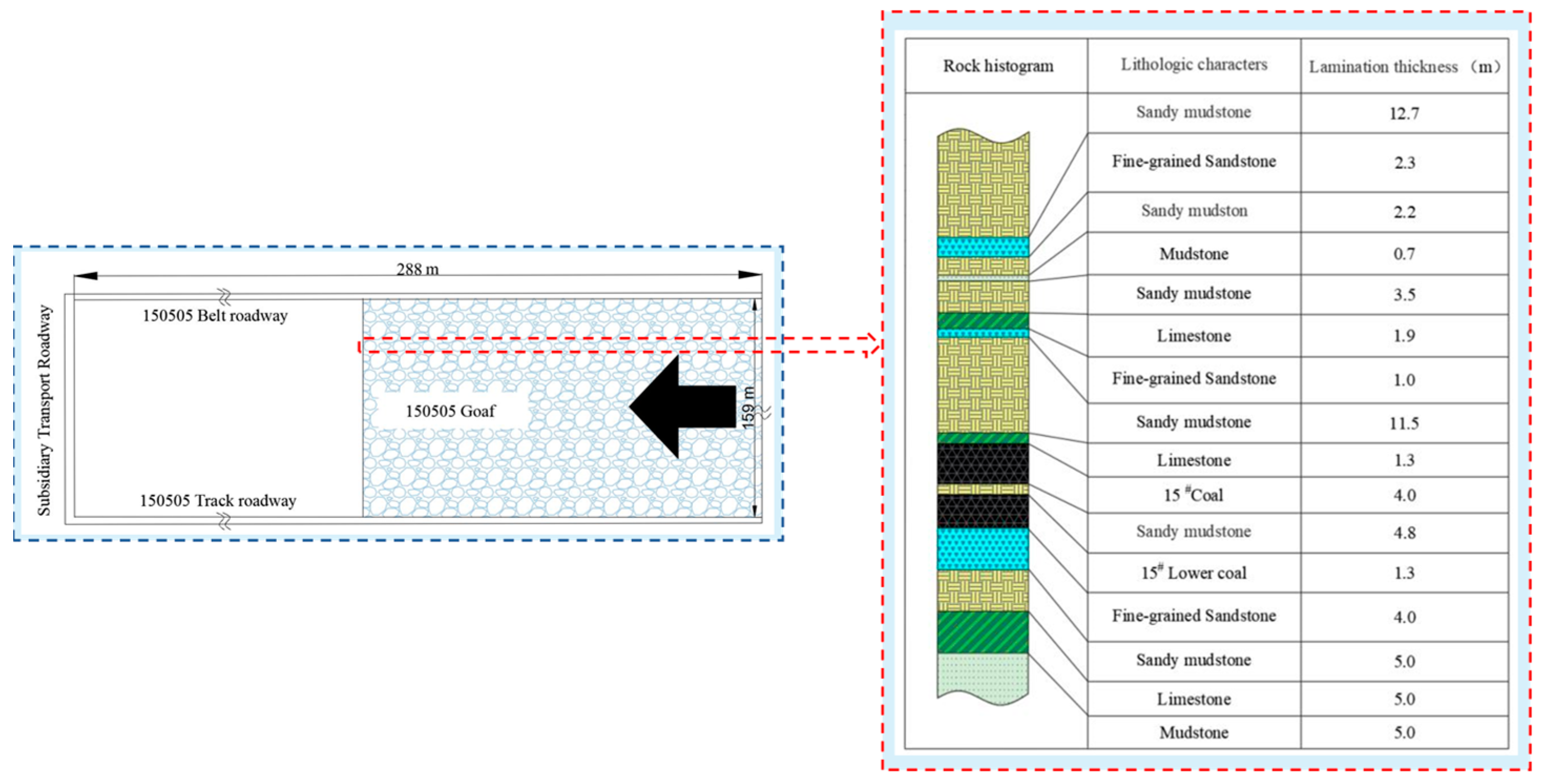



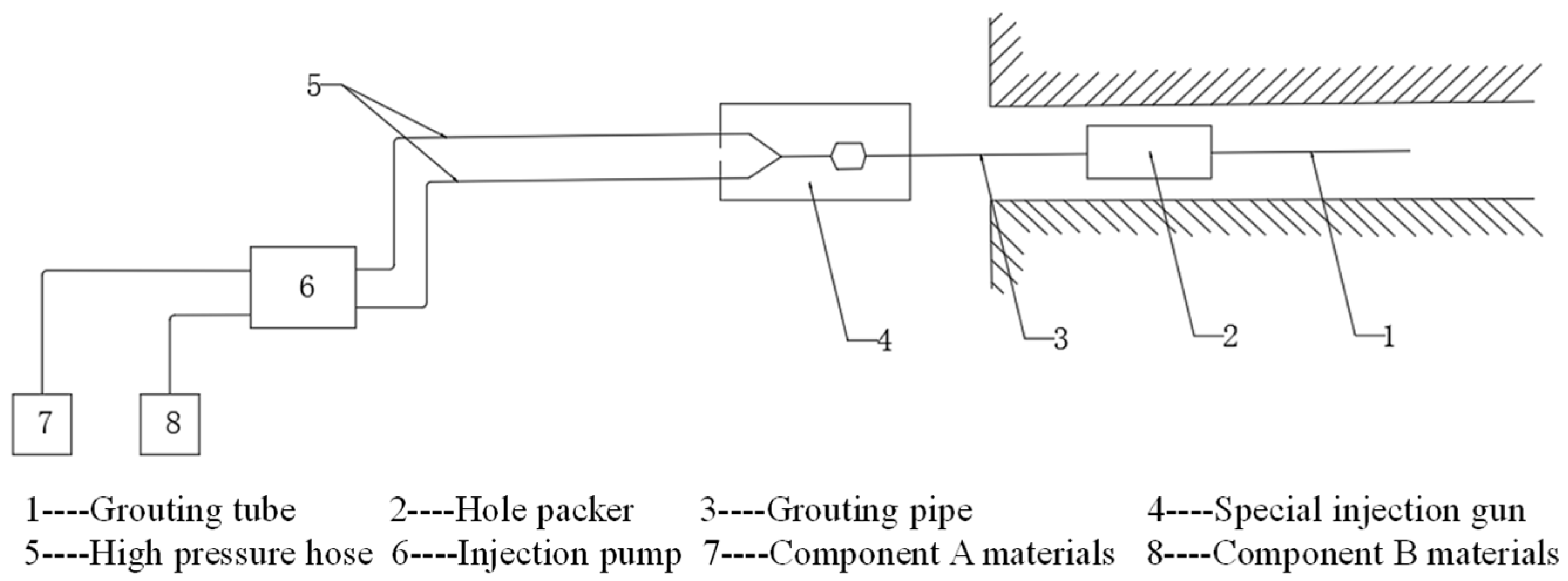

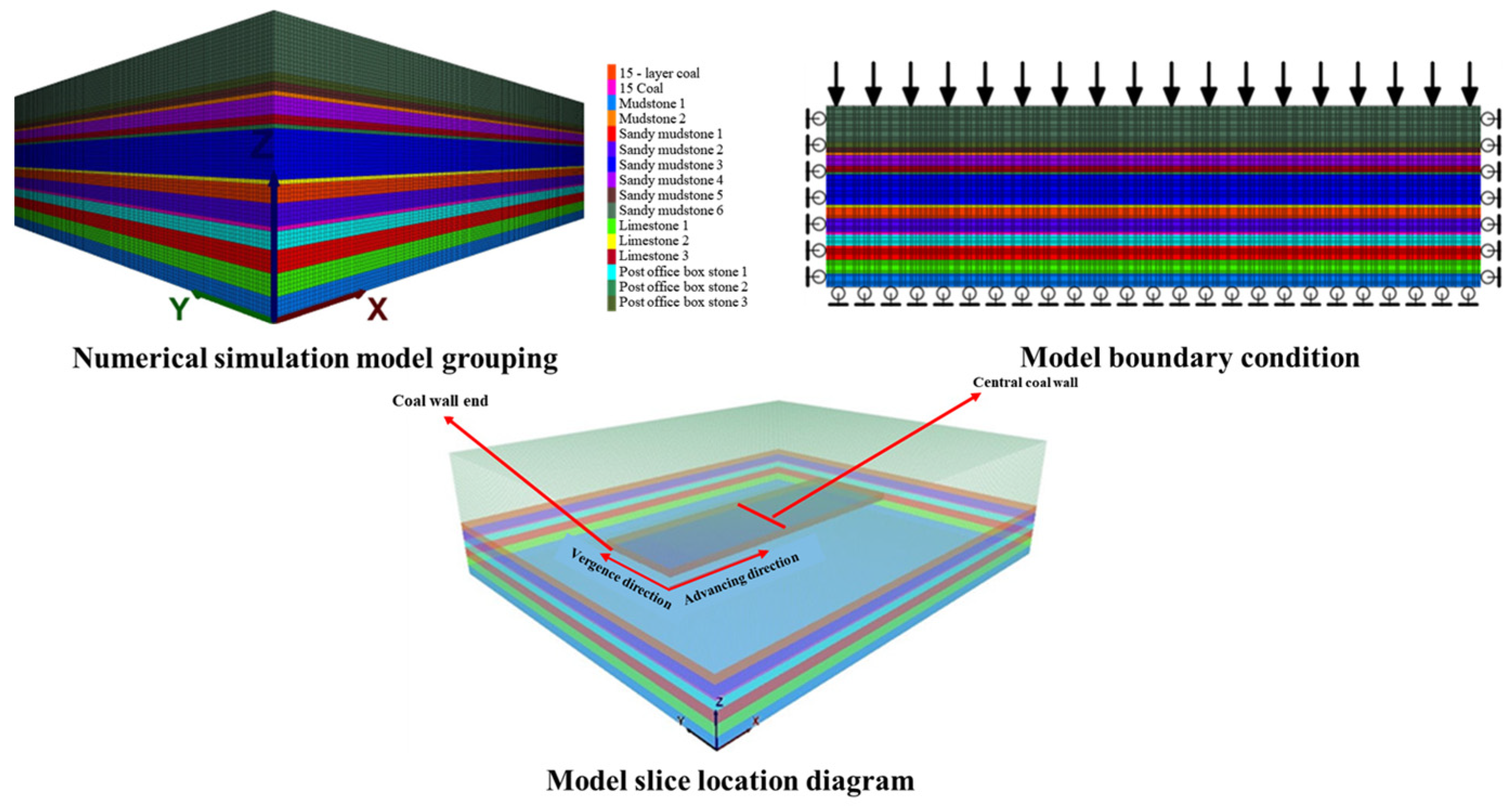

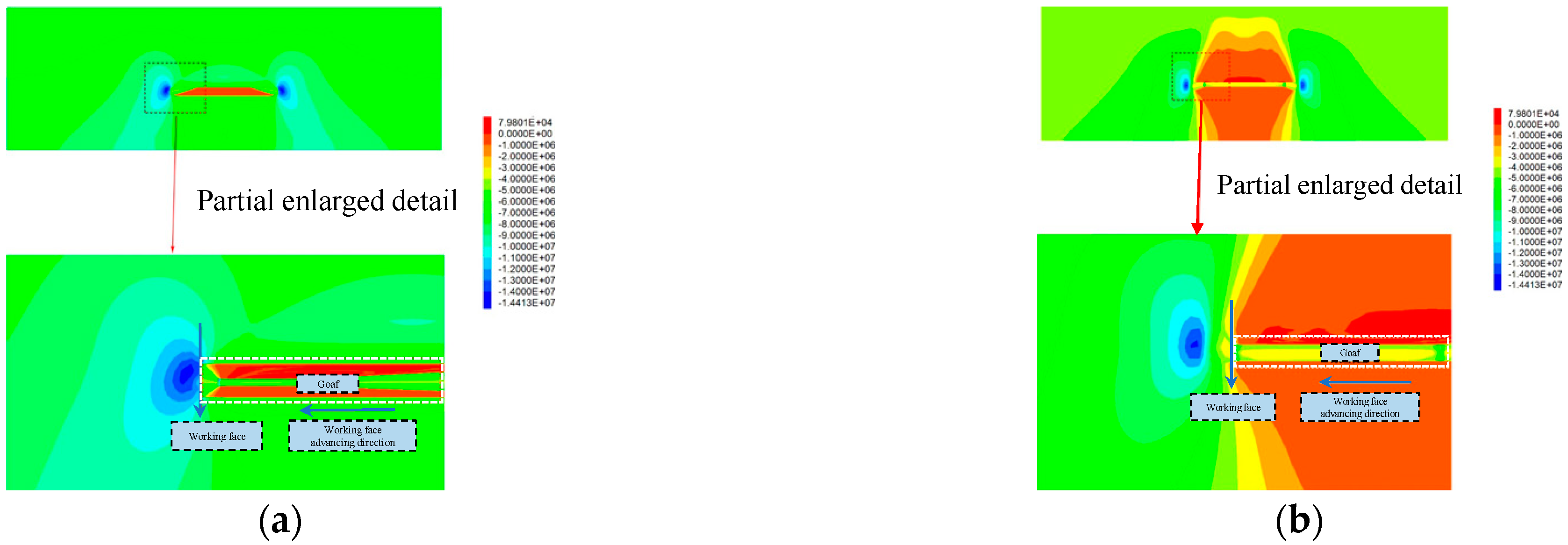
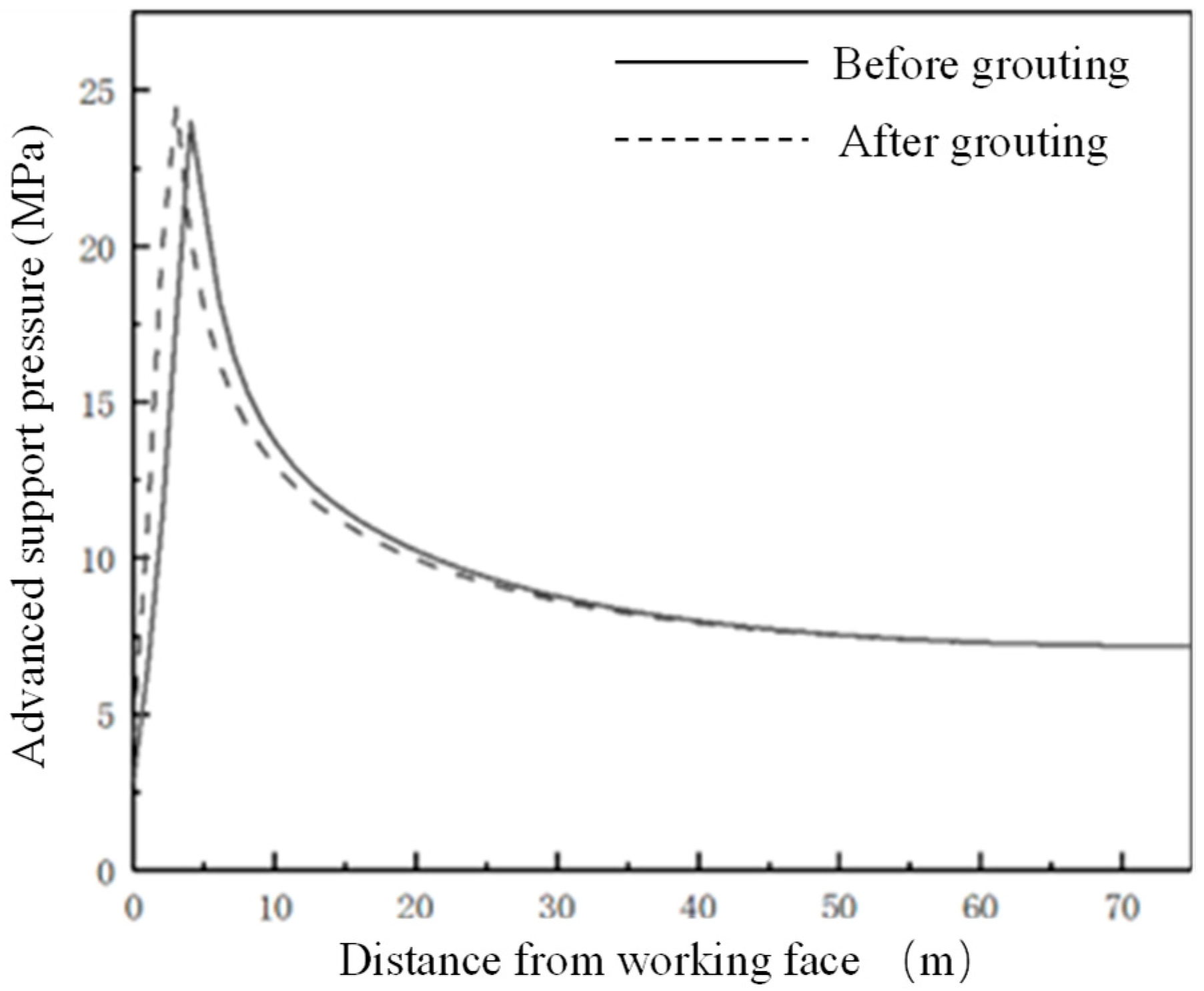
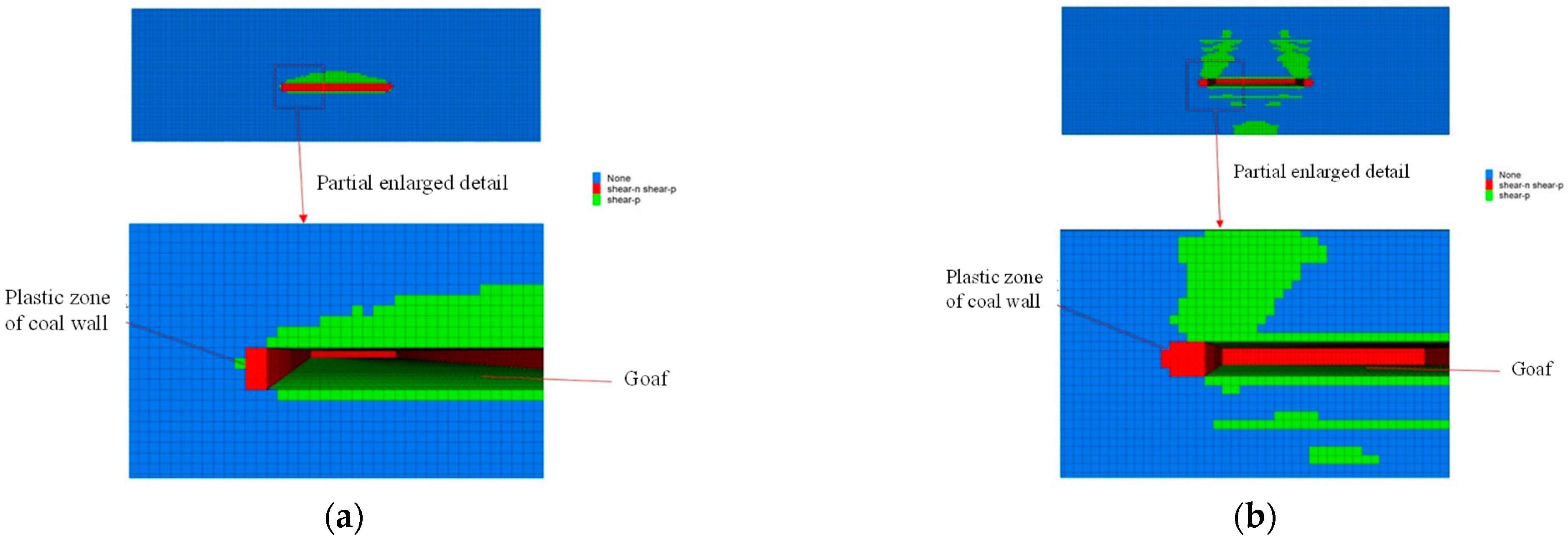


| Component A: | Weight/% | Component B: | Weight/% |
|---|---|---|---|
| Raw Material Name | Raw Material Name | ||
| Polyol | 0–98 | Isocyanate | 65–100 |
| Foam over stabilizer | 0–2.0 | Polyol | 0–10 |
| Catalyst | 0.4–0.8 | Plasticizer | 0–35 |
| Project | Standard Requirements | Test Results | ||
|---|---|---|---|---|
| Component A | Component B | |||
| Appearance | Homogeneity, No caking | Homogeneity; No caking | ||
| Flashpoint /°C | ≥100 | 225 | Not detected | |
| Curing time (23 ± 2) °C/s | —— | 40~100 | ||
| Expansion multiple /times | ≥1.0 | 2.0~3.0 | ||
| Ant aging performance (80 °C, 168 h) | No surface change, No mass loss | No surface change; No mass loss | ||
| Maximum reaction temperature /°C | ≤140 | 80~90 | ||
| Bond strength /MPa | ≥3.5 | 4.2 | ||
| Flame-retardant and anti-static properties | Meet standards MT113 | Non-combustible; anti-static performance meets the requirements of standard MT113 | ||
| Harmful | Benzene /g/kg | ≤5.0 | Not detected | |
| Material | Toluene + Xylene /g/kg | ≤150 | Not detected | |
| Limit | Total volatile organic compounds /g/L | ≤700 | 44 | |
| Quality guarantee period (At room temperature/month) | —— | ≥6 | ≥6 | |
| Serial Number | Lithologic Characters | Lamination Thickness (m) | Total Thickness (m) | Bulk Modulus (GPa) | Shear Modulus (GPa) | Cohesion (MPa) | Angle of Internal Friction (°) | Tensile Strength (MPa) |
|---|---|---|---|---|---|---|---|---|
| 16 | sandy mudstone | 12.70 | 67.20 | 7.01 | 4.50 | 1.93 | 29 | 2.50 |
| 15 | fine-grained sandstone | 2.30 | 54.50 | 8.95 | 5.89 | 2.12 | 29 | 3.00 |
| 14 | sandy mudstone | 2.20 | 52.20 | 7.01 | 4.50 | 1.93 | 29 | 2.50 |
| 13 | mudstone | 0.70 | 50.00 | 4.01 | 3.50 | 1.50 | 28 | 2.00 |
| 12 | sandy mudstone | 3.50 | 48.30 | 7.01 | 4.50 | 1.93 | 29 | 2.50 |
| 11 | limestone | 1.90 | 44.80 | 11.95 | 8.87 | 2.51 | 32 | 4.0 |
| 10 | fine-grained sandstone | 1.00 | 42.90 | 8.95 | 5.89 | 2.12 | 29 | 3.00 |
| 9 | sandy mudstone | 11.50 | 41.90 | 7.01 | 4.50 | 1.93 | 29 | 2.50 |
| 8 | limestone | 1.30 | 20.40 | 11.95 | 8.87 | 2.51 | 32 | 4.00 |
| 7 | #15 coal | 4.00 | 29.10 | 3.98 | 2.50 | 1.03 | 22 | 1.50 |
| 6 | sandy mudstone | 4.80 | 25.10 | 7.01 | 4.50 | 1.93 | 29 | 2.50 |
| 5 | #15 lower coal | 1.30 | 20.30 | 3.98 | 2.50 | 1.03 | 22 | 1.50 |
| 4 | fine-grained sandstone | 4.00 | 19.00 | 8.95 | 5.89 | 2.12 | 29 | 3.00 |
| 3 | sandy mudstone | 5.00 | 15.00 | 7.01 | 4.50 | 1.93 | 29 | 2.50 |
| 2 | limestone | 5.00 | 10.00 | 11.95 | 8.87 | 2.51 | 32 | 4.00 |
| 1 | mudstone | 5.00 | 5.00 | 4.01 | 3.50 | 1.50 | 28 | 2.00 |
Publisher’s Note: MDPI stays neutral with regard to jurisdictional claims in published maps and institutional affiliations. |
© 2022 by the authors. Licensee MDPI, Basel, Switzerland. This article is an open access article distributed under the terms and conditions of the Creative Commons Attribution (CC BY) license (https://creativecommons.org/licenses/by/4.0/).
Share and Cite
Liu, H.; Chen, Y.; Han, Z.; Liu, Q.; Luo, Z.; Cheng, W.; Zhang, H.; Qiu, S.; Wang, H. Coal Wall Spalling Mechanism and Grouting Reinforcement Technology of Large Mining Height Working Face. Sensors 2022, 22, 8675. https://doi.org/10.3390/s22228675
Liu H, Chen Y, Han Z, Liu Q, Luo Z, Cheng W, Zhang H, Qiu S, Wang H. Coal Wall Spalling Mechanism and Grouting Reinforcement Technology of Large Mining Height Working Face. Sensors. 2022; 22(22):8675. https://doi.org/10.3390/s22228675
Chicago/Turabian StyleLiu, Hongtao, Yang Chen, Zijun Han, Qinyu Liu, Zilong Luo, Wencong Cheng, Hongkai Zhang, Shizhu Qiu, and Haozhu Wang. 2022. "Coal Wall Spalling Mechanism and Grouting Reinforcement Technology of Large Mining Height Working Face" Sensors 22, no. 22: 8675. https://doi.org/10.3390/s22228675






